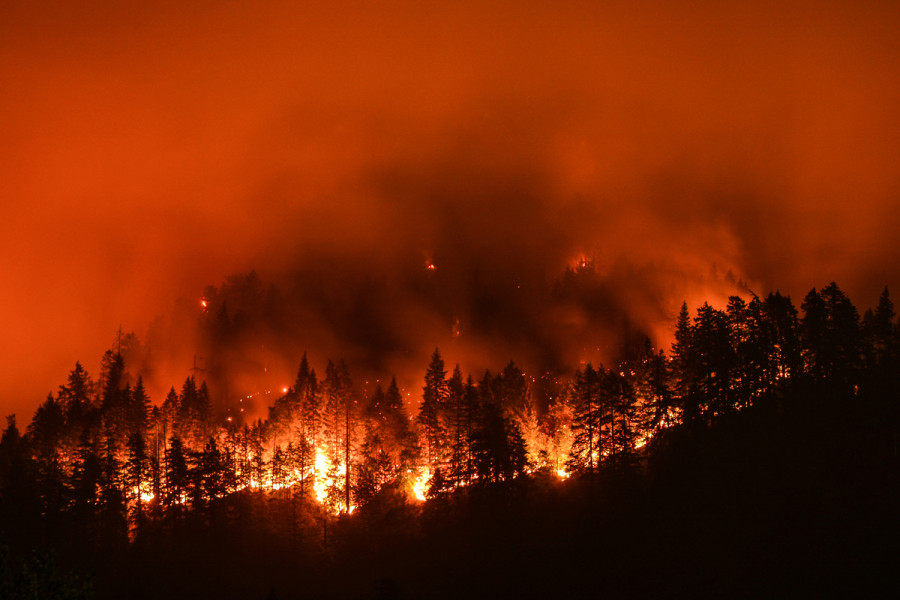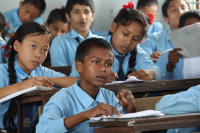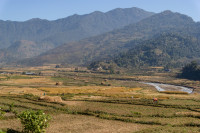Columns
Into the inferno
The loss of soil moisture and groundwater can, and need to, be addressed by large-scale local efforts.
Madhukar Upadhya
The forest fires sweeping through parts of the country have caught the public's attention lately, causing people to jump to the conclusion that rising temperatures and the dry winter are responsible for extensive fires. The story, however, needs further examination and understanding that goes beyond the usual suspects.
We've always had wildfires in Nepal. A youngster in the 1960s, I remember seeing fires on the southern face of the Shivapuri mountain every winter which burned for days, sometimes even weeks. Whether they were deliberately set by herders and foragers in the hopes of getting new grass growth with the first spring rains, or due to human negligence as studies suggest, forest fires were a regular occurrence in many parts of the country. In the mountains, forest fires are difficult to douse as drafts from the Valley below pushes the fire and it spreads in no time. In some cases, people collecting grass on hill slopes were caught unaware by the suddenly advancing fire from below, leaving them with no escape.
What's worrying now is that not only have forest fires increased in number in recent years, they've also increased in coverage; often, they are deadly. The 2009 Ramechhap incident is perhaps still fresh in our collective memory: 13 army personnel lost their lives while trying to douse a fire, some hundred kilometres east of Kathmandu. Moreover, forest fires seem to be destroying large swaths of forests, protected by years of efforts, adding to the already polluted air and throwing plumes of black carbon into the atmosphere, intensifying the snowmelt.
Fires at a higher elevation, away from settlements, continue for a long time because old and dead trees help keep the fire going for months, especially where there is no one to douse them. If the tree species happens to be pine, even green trees burn. Shifting demographics have gradually changed the way mountain resources are managed. Livestock grazing has gone down, leaving unattended high forest undergrowth. Dry winters with higher temperatures have only fueled these fires further.
Like many other grave environmental issues such as soil loss, declining soil fertility, increased level of spring losses, and land degradation, forest fires, which generally occur away from cities and don't directly affect city dwellers, haven't been prioritised in our development discourse.
However, the increased number of forest fires is highlighting other vital issues that have been pushed aside; for instance, groundwater that helped winter grass grow, which restricted wildfires, has depleted considerably in recent years. This loss of groundwater, along with soil moisture, has significantly altered the local ecosystem. A glaring example is the rapid growth of chir pine, a xeric tree species, in the hills of Panchthar where natural springs have dried, supporting the growth of such species. Many families have migrated elsewhere simply because water isn’t available in the local springs. The loss of water in one area is worrying; the Jhiku Khola in Panchkhal Valley of Kavre, which irrigated farms on the banks for decades, dried up during the mid-1990s and has ceased to flow except during the rains. The drying of springs, rivers, and ponds, including Kamal Pokhari in Kathmandu, needs to be seen in its entirety.
Within a watershed, the most basic unit of natural organisation in a landscape, whether in the hills or plains, the entire area is physically linked by the flow of water, both surficial and sub-surficial. There is an intricate balance, an interconnected relationship between water flow and natural organisations. Thus, the drying of Jhiku Khola or the ponds is the writing on the wall that things have changed irrevocably within their watersheds.
We have noted the loss of springs since the 1990s across the country, depicting various degrees of the same story. The loss of springs is a clear sign that the upper aquifers in the mountains have lost water. Saune mool—springs that appear in mid-monsoon when upper aquifers are full—have disappeared from our mountains for more than two decades confirming that the aquifers in the mountains didn't get to recharge to their full capacity. The high-intensity rain in recent years, like the ones that resulted in widespread landslides killing hundreds of people in 2020, has been of little help to recharge groundwater in the mountains where water flows down quickly without feeding the groundwater reserves. Four years ago, the Central Bureau of Statistics confirmed that 100 percent of sub-alpine households perceived an increase in drought in the last 25 years, a strong enough revelation about the changes that have taken place in the high mountain areas.
The loss of springs is not simply because of chir pine plantation in the early 1970s or road construction that cut the natural flow-lines; the loss has also been reported in road-less areas and areas lacking chir pine.
The 2015 Earthquake has further destroyed our aquifers, leaving the affected mountains dry. The science of mountain aquifers is poorly understood. April being a dry month, people seemed happy when water discharge in the springs increased abruptly in the aftermath of the earthquake; in reality, the earthquake squeezed the aquifers releasing what little water they had. This water was never replenished as the aquifer had gotten deformed. Since one cannot see the drop in the water level in aquifers, unlike in a pond, it didn't raise any concerns.
On top of these ground realities, when winter rain fails to arrive—like in 2009 and even now—it leaves the forest floor bone dry, making it an increased fire hazard with the already abundant fuel accumulated in the absence of collectors. Dry winters and rising temperatures will continue to threaten our forests.
Larger issues like climate change, which requires global efforts and more time to tackle, may not be within our reach to influence in the short run. However, the loss of soil moisture and groundwater can be and need to be addressed by large-scale local efforts, and thus should be our main worry. We must cease wasting time blaming pines or roads or even climate change individually for the loss of water, and by extension wildfires, as it suits one's objectives. Whether it's the drying of ponds such as Kamal Pokhari, or Kholas such as Jhiku, or increased forest fires, they aren’t isolated events. They are the manifestation of these larger issues we've neglected over the decades. Unfortunately, neither the government nor communities have made any efforts to understand the extent to which our springs or groundwater have been lost, much less to restoring them. In the end, we can continue singing the same tune, with little to show for it.




 14.12°C Kathmandu
14.12°C Kathmandu















